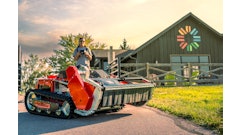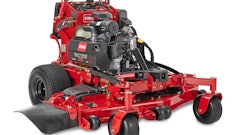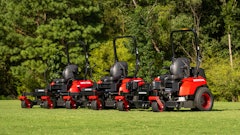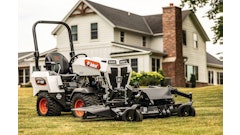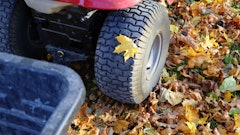
Autonomous commercial mowers are no longer futuristic concepts. These machines are now cutting grass on steep dam embankments, around solar farms, and on college campuses today. In an industry grappling with labor shortages and hazardous working conditions, these robotic mowers offer a twofold promise: enhanced safety and improved productivity.
However, delivering on that promise requires more than just GPS guidance and fancy sensors. At the heart of every safe autonomous mower are unsung heroes — the electromagnetic brakes and clutches — that enable reliable, precise control of motion and quick emergency response. Components like spring-applied brakes and blade clutches ensure that when a mower encounters an obstacle or emergency, it can halt its blades and wheels in an instant, keeping people and property safe. These brake and clutch systems are critical; today's manufacturers are leveraging them to build autonomous mowers that are both labor-saving and fail-safe in operation.
Autonomous Mowers Rise to Meet Labor Shortfalls
Nearly 80 percent of landscaping companies are struggling to fill open positions, according to a National Association of Landscape Professionals survey.
The push toward autonomous mowing didn’t happen in a vacuum. Rather, it’s answering a real crisis in the landscaping workforce. Contractors across the country have struggled to find crew members to mow vast properties. Nearly 80 percent of landscaping companies are struggling to fill open positions, according to a National Association of Landscape Professionals survey.
Seasoned employees are aging out. Younger workers are hard to attract for repetitive mowing jobs. These labor pains, accelerated by the pandemic, opened the door for robotic solutions. Many have had to invest in automated solutions to relieve staffing pressures.
Indeed, a single autonomous unit can often allow one operator to do the work of an entire crew, freeing human workers for more skilled tasks or additional projects. The consistent availability and endurance of robots mean crews can maintain schedules even when labor is tight or weather causes delays.
In short, autonomous mowers are becoming indispensable partners, tackling the drudgery of lawn mowing amid a skilled labor shortage while humans focus on higher-value landscaping work.
But autonomy cannot come at the expense of safety. These machines must be engineered to operate without direct human control at least as safely as traditional mowers. This places functional safety systems front and center in autonomous mower design. Brakes and clutches play a pivotal role here. They are the physical mechanism by which a mower can stop itself, whether halting forward motion on a dime or disengaging spinning blades instantly when a person or obstacle is detected.
Functional Safety: Stopping Fast When It Counts
Mowers are powerful machines, and in autonomous mode they often work near people, buildings, or vehicles that could be at risk if something goes wrong. Functional safety features ensure that if a mower encounters an unexpected situation (a child running into its path, a fallen branch, a loss of signal or control), it can transition to a safe state immediately.
For rotary mowers, the most dangerous element is the cutting system with blades spinning at thousands of RPM. Industry safety standards acknowledge this risk by requiring mowers to have blade braking systems. In fact, ANSI B71.1 (for consumer turf mowers) recommends that blades come to a complete stop within 5 seconds of the operator releasing the blade control, and ANSI B71.4 (for commercial mowers) allows up to 7 seconds, given the larger machines’ inertia. These standards were developed to prevent injuries by ensuring blades don’t spin down for ages after shutdown.
Modern electric PTO clutch-brakes are designed to meet or exceed these guidelines. They serve as both the clutch to transmit power to the blades and a brake (to quickly stop blade rotation when power is cut). An electromagnetic PTO clutch-brake (left) paired with a playful “five-second rule” reminder (right). Industry standards mandate that mower blades stop within about 5 seconds of disengagement for safety. Some of today's PTO clutches even incorporate an internal brake mechanism that halts the blade’s inertia quickly when power is removed.
Over the past decade, more than 1,000 work-related fatalities occurred in the landscaping industry, many related to equipment.
Stopping blade rotation rapidly is not just a regulatory checkbox, but a real lifesaver. U.S. landscaping crews still see dozens of serious mower accidents each year from objects thrown by blades or inadvertent contact. Over the past decade, more than 1,000 work-related fatalities occurred in the landscaping industry (142 in 2021 alone), many related to equipment.
That sobering statistic drives home why emergency stop capabilities are critical. If an autonomous mower’s sensors detect a person or obstacle in the way, the machine needs to immediately disengage its mowing deck and begin braking. Electromagnetic clutches excel here: they use an energized coil to engage the mower blades when mowing, and springs to yank a brake pad against the clutch disk when power is cut, decelerating the blades to a standstill. In essence, the moment an autonomous mower decides to stop, these clutches act as mechanical reflexes, instantly cutting power transmission and actively braking the blade.
For example, steel-on-steel brakes utilize a simple, robust mechanism that reliably stops heavy blades within the required timeframe. Such clutch-brake units are purpose-built safety devices on mowing equipment.
Of course, the drive wheels or tracks of an autonomous mower must also be brought under control in an emergency. This is where spring-applied fail-safe brakes come in. Often mounted on the drive motors or transmission, these brakes are held disengaged by electric power during normal operation and automatically clamp tight if power is lost or an emergency stop is commanded. This fail-safe design means that a severed wireless link or software crash won’t send a 1,000-pound mower careening out of control. Instead, the brakes engage and bring it to a halt.
For instance, on the Ferris FRC7 remote mower, the safety system includes an “automatic fail-safe brake” that triggers whenever the remote control signal is lost or the e-stop is hit. Similarly, the Spider line of slope mowers is engineered such that all four wheels lock in case of power loss, preventing unintended movement on hills. These examples highlight a common theme in autonomous mower safety: default to brake. Powerful springs or other mechanisms ensure that “no command” translates to “full stop” — a vital principle when human supervisors might be hundreds of feet away.
More about robotic mowers on GreenIndustryPros.comIs the Robotic Lawn Mower an Answer to the Green Industry Labor Shortage? - The green industry could be changing its attitude toward robotic mowers now due to the labor shortage. The 3 Keys to Onboarding Autonomous Mowers - Autonomous mowing experts explain how landscape professionals can adopt robotic mowing technology. How Could Robotic Mowers Benefit Landscaping Pros? - Learn all about robotic lawnmowers, the technology behind them and what they could mean for the landscaping industry |
Electromagnetic Clutches Keep Blades in Check
The blade clutch is the interface between the mower’s power source (whether a gasoline engine or electric motor) and the spinning blades. In autonomous mowers, blade engagement is typically computer-controlled without a human hand on a PTO switch. Instead, the machine’s control system actuates the clutch based on its programming and sensor inputs. A high-quality electromagnetic clutch gives the autonomous mower precise control over the blades. It can energize the clutch coil to start mowing instantly when reaching a grassy zone, and disengage just as easily when stopping or when traveling over pavement.
This precise on-demand control not only improves efficiency (i.e., only mow when you need to) but is also key to safety. If the mower’s vision or LiDAR system spots debris or a person, it can cut power to the clutch in a split second, causing the blades to disengage — a feature that helps prevent accidents and injuries.
Equally important, when an electromagnetic clutch disengages, it doesn’t just freewheel, it brakes the blade rotation. As described earlier, most mower clutches for autonomous or remote-operated units are actually clutch-brake combos. The friction material and spring mechanism inside rapidly slow the heavy spinning blade spindles as soon as mowing is paused. This dual-function design is elegantly simple: one device serves to connect and disconnect power, and to provide a safety brake.
Some of today's clutch brakes, for example, engage the blades when energized and then use stored spring force to stop them when de-energized, all in one sealed unit. The advantage is fewer components to fail and a guaranteed braking action every time. Wright Manufacturing, maker of the Autonomous Stander ZK mower, equips its commercial mowers with heavy-duty clutch-brakes for exactly this reason. Wright selects clutches that “last the longest, stop the fastest” in testing, knowing that most PTO clutches wear out on the brake side from all the emergency stops and blade braking over their life.
By specifying robust clutches (some rated over 300 lb-ft of torque for the big Stander ZK models), they ensure the autonomous mower can handle the frequent engage/disengage cycles and sudden stops demanded by automation. The result is precise blade engagement when cutting — and confidence that when the software says “stop,” the blades actually halt within seconds.
Fail-Safe Brakes Anchor Stability on Slopes
One of the most challenging (and popular) use-cases for autonomous and remote-operated mowers is slope mowing. Steep hillsides pose a serious safety risk to human operators, considering ride-on mowers can tip over, and walking behind a mower on a 45-degree slope with a weed trimmer is a recipe for slips and falls. It’s no surprise that many early adopters of unmanned mowers are those maintaining berms, levees, and highway embankments.
However, mowing on a gradient means gravity is constantly pulling the machine downhill. If an autonomous mower loses drive power or fails to brake on a slope, it could roll away uncontrolled. This is why spring-applied parking brakes are essential on autonomous slope mowers. These brakes automatically engage (often locking the drive wheels or tracks) whenever the machine is not actively moving uphill or downhill under power.
For example, Spider remote-controlled mowers, which can tackle extreme slopes up to 60 degrees, boast that if power is lost, the machine’s wheel brakes lock to prevent any runaway descent. In practice, this means even on a 45-degree incline, if someone hits the emergency stop or the mower loses connection, it will skid to a stop and hold itself firmly in place.
It’s no surprise that many early adopters of unmanned mowers are those maintaining berms, levees, and highway embankments.
A remote operator supervises a pair of tracked robotic mowers tackling a steep, brush-covered slope. On hazardous terrain like this, safety systems are crucial — from low centers of gravity and stabilizing winches, to fail-safe brakes that lock the tracks if control is lost. Autonomous and remote mowers open up such areas to maintenance without putting human operators in harm’s way.
Mechanical brakes on autonomous mowers take various forms. Some electric-drive units use dedicated electromagnetic drum or disc brakes on each wheel motor. These are often the spring-applied type, which are energized to release and spring-engaged to lock the wheel. Other mowers with hydrostatic drives achieve a similar effect with integrated hydro motor brakes. The common theme is a design that defaults to maximum braking unless actively commanded to move.
The recently introduced Slope-Pro remote mower (Progressive Turf Equipment) illustrates this well: its spec sheet highlights independent hydrostatic wheel drives “with integrated fail-safe brakes,” and notes that the cutting deck is driven by an electromagnetic clutch with remote interlock. In other words, it has park brakes built into each wheel motor that automatically secure the machine on slopes whenever the controller isn’t driving it, plus an electric clutch to control the blades — a comprehensive approach to slope safety.
Another slope solution, used by Spider and some others, is a stabilizing winch that can tether the mower on extreme angles. In Spider’s case, a hydraulic winch keeps the mower from flipping backward on 60-degree inclines but, notably, does not pull the mower. Instead, the tracks or wheels still do the driving while the winch just provides extra hold. This allows the mower to maintain traction and balance without manual intervention or dangerous rigging by an operator.
Importantly, even with such aids, the fundamental requirement remains: reliable brakes that prevent movement when needed. It’s these brakes that give engineers and users the confidence that an unmanned machine can work on a hill without suddenly rolling into a roadway or crashing at the bottom.
This is Part 1 of 2 on the role of brakes and clutch technology in autonomous mowers.

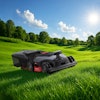
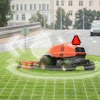
![Gravely Pro Turn Mach One My23 Dsc03139 Edit 1200x800 5b2df79[1]](https://img.greenindustrypros.com/mindful/acbm/workspaces/default/uploads/2025/10/gravely-pro-turn-mach-one-my23-dsc03139-edit-1200x800-5b2df791.BucBnDoN22.jpg?auto=format%2Ccompress&fit=crop&h=100&q=70&w=100)
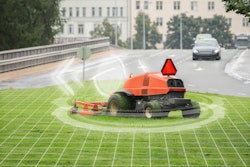

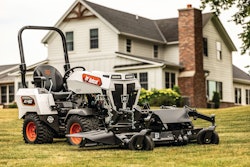
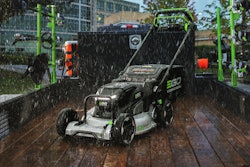
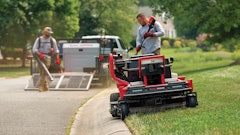

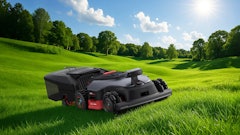
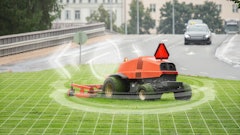
![Gravely Pro Turn Mach One My23 Dsc03139 Edit 1200x800 5b2df79[1]](https://img.greenindustrypros.com/mindful/acbm/workspaces/default/uploads/2025/10/gravely-pro-turn-mach-one-my23-dsc03139-edit-1200x800-5b2df791.BucBnDoN22.jpg?ar=16%3A9&auto=format%2Ccompress&fit=crop&h=135&q=70&w=240)
